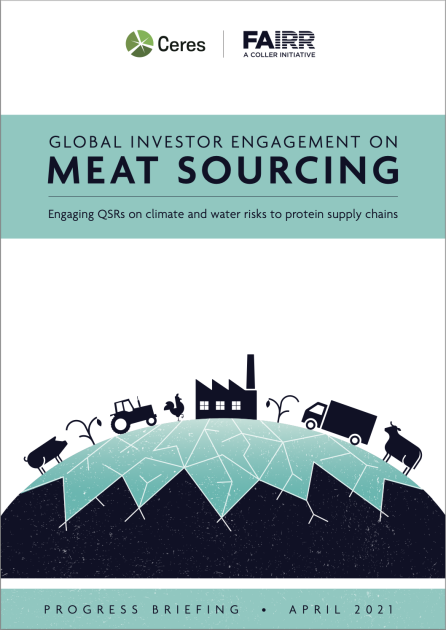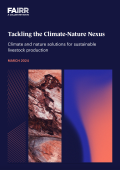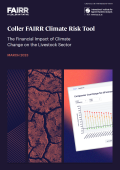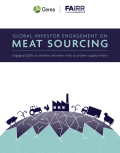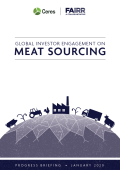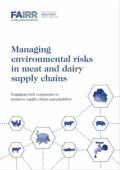Executive Summary
The Global Investor Engagement on Meat Sourcing, initiated in 2019, consists of dialogues between six of the largest quick-service restaurant (QSR) brands and institutional investors with over $11 trillion in combined assets. Investors have urged the QSRs to analyse and reduce their vulnerability to the impacts of climate change, water scarcity, and pervasive threats to water quality driven by animal protein production.
Companies have made notable progress in addressing these concerns. All six target companies have now publicly stated they will set or have already set global GHG reduction targets. Five of the six QSRs have now set, or committed to setting, emissions reduction targets approved by the Science-Based Targets initiative (SBTi) that would align their businesses with the Paris Agreement’s goal to limit global temperature rises to well below 2°C.
However, progress towards mitigating risks related to water scarcity and pollution has been limited. In addition, only two of the six companies have disclosed plans to conduct a 2°C scenario analysis, a key recommendation of the Task Force on Climate-Related Financial Disclosures (TCFD). While the progress to date is encouraging, there are critical elements yet to be addressed around climate and water-related financial risks.
The Case for Engagement
Prior to the start of this engagement in 2019, many institutional investors had come to appreciate the materiality of climate and water risks posed to quick-service restaurants through their livestock supply chains. More details on the business risks to QSRs associated with these environmental threats can be found in the engagement’s January 2020 Progress Briefing and the sample letter sent to companies by this investor coalition in 2019. In 2020, we saw an increasing number of calls for enhanced climate change-related disclosures and new academic evidence underscoring the materiality of these issues to the meat sourcing value chain.
Investors are increasingly adopting ambitious climate change targets and are engaging with portfolio companies on plans to align with limiting warming to 1.5 degrees celsius. The investor participants in the Net Zero Asset Owners Alliance and Net Zero Asset Managers Initiative have committed to supporting the goal of net-zero greenhouse gas emissions by 2050, in line with global efforts to meet the Paris Agreement; and to supporting investing aligned with net-zero emissions by 2050. The targets are increasingly becoming a priority for large, conventional asset managers: these initiatives are supported by 33 investor signatories with $5.5 trillion in assets under management (AUM) and 87 signatories with $37 trillion in AUM respectively.
New guidance and regulations to improve climate-related disclosures and financial stability will likely continue to drive this trend. In November 2020, the UK announced that companies will be legally required to report on climate risks in line with the Task Force on Climate-Related Disclosures (TCFD) recommendations by 2025. The new rules will apply to a wide range of companies, including listed commercial companies, UK-registered large private companies, banks, building societies, insurance companies, UK-authorised asset managers, life insurers, FCA-regulated pension schemes and occupational pension schemes.
The US does not yet have binding regulations on reporting climate risks, but calls for regulatory advancements are growing. The US Commodity Futures Trading Commission’s Market Risk Advisory Committee (MRAC) released a report detailing 53 recommendations to mitigate climate risks to the financial system. Noting that climate change presents “a major risk to the stability of the US financial system”, the report recommends that US regulators must “move urgently and decisively to measure, understand, and address these risks” and that the finance industry must direct capital towards accelerating the net-zero transition. The US Federal Reserve has acknowledged that climate change increases financial stability risks and is calling for increased disclosure against these risks, as well as further research to help incorporate climate risks into financial stability monitoring.
New environmental regulations directly impacting the livestock industry may increase operational costs and disrupt protein producers’ business models, increasing risk to quick-service restaurant supply chains and potentially reducing profit margins. Water quality and quantity transition risks are a significant concern. In the US, the Biden administration has signalled its intent to implement regulatory changes that could directly impact meat supply chains. Biden’s $2 trillion climate plan may include broader regulation and updated nationwide standards, while increased enforcement of the Clean Water Act (CWA) – the primary federal law controlling and preventing water pollution in the US meat supply chains – could lead to stricter effluent discharge guidelines and penalties for CWA violations at the factory farm level, causing a potential increase in reputational and financial risk. QSRs could also face significant impacts from legislative reforms. For example, if adopted the Farm System Reform Act (FSRA) would immediately prohibit the creation and expansion of concentrated animal feeding operations and require a total phase-out by 2040. Legislative proposals like the FSRA indicate that the environmental impacts of large meat producers are drawing more attention from lawmakers.
Calls for a ‘meat tax’ have grown, especially in Europe. The tax would increase the price of livestock products. FAIRR’s report, The Livestock Levy, identifies several steps that led to the implementation of behavioural taxes on tobacco, carbon and sugar, and argues that the first step for a meat tax may have already been taken.
While meat taxes are not yet a reality, some of the companies in this engagement recognise this as a material transition risk. McDonald’s identifies potential regulation impacting franchisees and suppliers as a climate-related risk that could increase raw material costs, and is likely to emerge in the medium term. Yum! Brands also recognises environmental regulation impacting franchisees and suppliers as a material risk, but ranks this as a long-term, unlikely risk.
There is mounting scientific research demonstrating the high environmental impact of meat and dairy products and the vulnerability of livestock production to climate and water risk. The latest academic work on this issue further underscores the impact these risks will have on the animal agriculture industry. A report issued in 2020 by the United Nations Environmental Program Finance Initiative (UNEP FI) suggests that, under an ambitious transition scenario, intensively grazed beef will have the highest transition costs amongst the whole agricultural and forestry sector. The report suggests these costs will arise from tightly controlled land-use practices, carbon taxes, shifts to plant-based diets, increases in meat substitutes, and rising prices for resource-intensive crops.
A recent study from the University of Minnesota underscored the meat supply chain’s vulnerability to water stress in North America. The analysis found that 78% of irrigated feed is consolidated in just six companies. The study also found that the largest meat companies have the highest proportion of their feed sourced from areas facing chronic or seasonal water shortages. National Beef, Cargill, JBS, Smithfield Foods and Tyson Foods all have over half of their feed sourced from these vulnerable areas. These companies are critical to the supply chains of the six focus QSRs of this engagement.
Step 1: Scientific evidence of negative societal impacts culminating in international consensus, backed by a UN body. | WHO’s International Agency for Research on Cancer ranks processed meats as Group 1 carcinogens and identifies red meat as a probable cause of cancer (2015). The IPCC Special Report on Climate Change and Land concludes that reductions in meat consumption and deforestation are likely to be required to solve the climate crisis. |
Step 2: A compelling financial public benefit case to justify the imposition of a tax. This usually justifies cost incurred now (tax) to avoid the risks of more severe consequences in the future. | Research by Oxford University concludes that a health tax on red and processed meat could save over $40 billion in global healthcare costs (2018). |
Step 3: The emergence of evidence and/or political support that a tax can help lessen the societal/environmental harm being caused. | The case for whether a ‘meat tax’ would result in the desired environmental and health outcomes is unknown. |
Step 4: Current state of taxation levels | Proposals for some form of ‘meat tax’ have been discussed in Sweden, Denmark, Germany, New Zealand and the Netherlands. |
Trends in Company Performance
Board oversight and ESG risk management capacity
For the first time, all six companies now acknowledge the materiality of climate and water risks to their supply chains in their annual financial filings. This is an important step towards integrating sound management of these issues across their operations, and suggests that the companies will be dedicating more resources to addressing these risks going forward.
Companies are enhancing board oversight of sustainability broadly, but it remains unclear if climate and water risks specific to livestock production are discussed on a regular basis. Companies should disclose this information more widely, and ensure that climate and water risks specific to protein supply chains are a specific and formal agenda item for each board meeting. Over the last year, progress in this area included:
In its 2021 proxy statement, Domino’s clarified that environmental risks to its meat supply chain were regularly on its board’s agenda.
McDonald’s Board of Directors includes a sustainability and corporate responsibility committee that has oversight of climate and water commitments, among other issues. The company disclosed to signatories how frequently its executive team meets with this committee. Investors have encouraged the company to disclose this information publicly.
Restaurant Brands International does not yet have a board committee focused on sustainability or ESG risks. The company privately disclosed to signatories how frequently ESG is discussed at the board level. Investors have encouraged the company to disclose this information publicly.
In its CDP Climate Change report, Yum! Brands states that the board is updated annually on ESG issues through its audit committee, but does not specify whether livestock supply chain risks in particular are discussed.
Wendy’s Corporate Social Responsibility Committee convened twice in 2020. The company specified that, among other sustainability-related matters, the committee is tasked with reviewing risk management practices to “ensure a sustainable and resilient supply chain.”
Companies have added internal staff capacity focused on managing ESG risks with a growing focus on meat and dairy supply chains.
Wendy’s announced the completion of its ESG materiality assessment, pledging that the assessment would inform target setting moving forward. The assessment labelled “Climate, Energy, & Water” among the most material topics to the company and stakeholders.
Domino’s added internal sustainability-focused staff and reported that it is “working with outside experts to determine [its] environmental baselines and developing initiatives to reduce [its] impact on the environment, including the impact of energy, waste water, land use and waste reduction, both in [its] packaging and food.”
Chipotle became the first of the six QSRs to explicitly tie executive compensation to sustainability goals, including the company’s goal to measure its Scope 3 emissions by the end of 2021. The company also created an internal climate steering committee focused on curbing emissions and managing climate risks.
Emissions reduction targets
There is growing consensus on the need for more focus on reducing emissions and managing climate risk in agriculture, forestry, and other land use (AFOLU) sectors. Collaborative investor engagement initiatives on climate change such as the Climate Action 100+ and Transition Pathway Initiative that have focused on certain high-emitting sectors, such as energy, transport and heavy industry, have begun to expand their coverage to the food and beverage sector broadly.
However, until recently, there was limited standardised guidance available for companies to account for emissions from livestock production and land use change. Now, standard setters are releasing more agriculture-specific guidance: the Science Based Targets initiative (SBTi) is developing guidelines on GHG target-setting for the forests, land, and agriculture sectors, while the GHG Protocol is developing new guidance on accounting for emissions from animal products and land use change.
Addressing emissions reduction in livestock supply chains is crucial for quick-service restaurants, as this is where the majority of their emissions arise from. In 2020, RBI completed a lifecycle assessment of food, beverage, and packaging categories to assess carbon, water, and waste impacts, and measured its Scope 1, 2, and 3 emissions. The company found that Scope 3 emissions account for >99% of its total footprint. Of its Scope 3 emissions, franchisee energy makes up 15%, and purchased goods and services comprise 82% – and its key proteins, beef, chicken and dairy, account for 67% of total Scope 3 emissions.
Companies have made notable progress on setting GHG targets: all six target companies have now publicly stated they will set or have already set global GHG reduction targets. Five of the six QSRs have now set or committed to setting best-practice emissions reduction targets approved by the Science-Based Targets initiative (SBTi) that would align their businesses with the Paris Agreement’s goal to limit global temperature rises to well below 2°C.
At the start of this engagement in January 2019, McDonald’s was the only company to have already set an SBT.
In April 2021, Yum! Brands announced that it has set an SBT consistent with a 1.5-degree warming pathway. The company now has the most ambitious climate target among its peers in this engagement. Yum! Brands has committed to reduce its absolute Scope 1 and 2 emissions by 46% by 2030 from 2019 levels. It will reduce its Scope 3 emissions by 46% during the same timeframe on a per-restaurant basis for franchisees and a per-metric ton basis for beef, poultry, dairy and packaging. The company also pledged to achieve net-zero emissions by 2050.
In April 2020, Chipotle committed to set a science-based target. The company specified that it aims to have its target validated by the SBTi by the end of 2021. As a result, the company moved up its target date for the measurement of its Scope 3 emissions from 2025 to 2021.
In February 2021, Domino’s announced that it intends to establish science-based targets to reduce “the Company’s total contribution to climate change” within the next one to three years.
In April 2021, Wendy’s announced that by the end of the year it intends to conduct a lifecycle assessment of its Scope 3 emissions and commit to the SBTi to begin developing a science-based target inclusive of Scope 3 emissions. The company aims to have the target validated by the SBTi by the end of 2023.
RBI made considerable internal progress on climate action throughout 2020 and disclosed it will soon set global GHG reduction targets – though it is not yet clear whether the targets will be set in accordance with the SBTi. The company acknowledges the importance of reducing emissions from livestock production, noting there is a “clear opportunity” to address emissions in this category. Consequently, it is likely that the company’s upcoming GHG target will address agricultural emissions in Scope 3.
TCFD-aligned scenario analysis
Rapidly increasing public support for assessing and reporting on climate risks has, so far, not resulted in increased disclosure. The Task Force for Climate-related Financial Disclosures (TCFD) issued recommendations in 2017 to help companies disclose supplementary data to enable financial markets to better understand climate-related financial risks and opportunities. As of October 2020, over 1,500 companies and financial institutions had declared their support for the TCFD recommendations. Despite this strong public support, an assessment of more than 1,700 publicly-listed banks, insurance firms, and corporations found that disclosures of TCFD-aligned information increased by only 6% between 2017 and 2019.
The food sector is falling behind: A review conducted by the TCFD found that, within the agriculture, food, and forest products sector, the percentage of disclosures relating to strategy for climate-related risks and opportunities fell by 7% between 2017 to 2019. The review further noted that disclosures against the ‘resilience of strategy’ indicator were particularly low for the sector and did not show any improvement across three years from 2017 to 2019. The results also show that the sector is lacking in governance-related disclosures.
As well as being a major contributor to GHG emissions, livestock production (and agriculture as a whole) is extremely vulnerable to climate risk. According to the Intergovernmental Panel on Climate Change (IPCC), animal agriculture systems will suffer increased costs of water, feed, and infrastructure damage due to extreme weather events, as well as lower animal productivity. Globally, rangeland livestock is predicted to drop by 7-10% in a 2°C warming scenario, with “considerable economic consequences for many communities and regions”, says the IPCC Special Report on Climate Change and Land (2019). Companies that rely on livestock products are at risk of lower product availability and therefore higher costs in protein supply chains. In total, the Coller FAIRR Climate Risk Tool identifies seven direct risks that impact the profitability of the meat sector: the growth of meat substitutions; a CO2 price on meat; increased veterinary costs; a CO2 price on electricity; increased feed costs; increased electricity costs and increased mortality rates in livestock.
Despite agriculture’s high exposure to climate risks, companies in this industry are only just beginning to conduct scenario analyses to better understand how these issues may impact their business operations and supply chains. QSRs can learn from peers and suppliers that have begun this process and use their findings to help inform their own analyses: see the Coller FAIRR Protein Producer Index: GHG Emissions Report for discussion of Brazilian beef producer Marfrig and New Zealand dairy producer Fonterra’s climate scenario analyses. The common theme of regulation and carbon taxes in both analyses implies that the cost of raw materials from agricultural suppliers may increase and impact companies’ profit margins.
Company progress
As of 2019, McDonald’s was the only company in this engagement to publicly commit to conducting a scenario analysis within the next two years. This commitment was disclosed in 2019, suggesting the company may be ready to disclose a completed analysis in 2021.
In 2020, a second company – Yum! Brands – committed to conducting a qualitative and/or quantitative climate-related scenario analysis in the next two years.
The remaining four companies – Wendy’s, Chipotle, Domino’s, and RBI – have yet to publicly commit to conducting a climate scenario analysis based on TCFD guidelines.
Despite making substantial progress towards setting emissions reduction targets over the last year, efforts towards mitigating risks related to water scarcity and pollution from meat supply chains have been more limited. Domino’s and Wendy’s have yet to disclose if they are conducting water risk assessments of their animal protein supply chains – a foundational step in prioritising which vulnerabilities and regions should receive the most attention. (Wendy’s recently disclosed that it has undertaken a water risk assessment of its Company-operated restaurants).
Nonetheless, several of the focus companies have undertaken efforts to promote sustainable agricultural practices that can address emissions, water availability, and water quality simultaneously:
RBI has yet to disclose specific water use or quality performance data or targets. However, it measured its supply chain water use for the first time through a lifecycle assessment conducted in 2020, which will inform its responsible sourcing strategy going forward.
Burger King – a subsidiary of RBI – partnered with Cargill and the World Wildlife Fund to launch a grasslands restoration programme in the Northern Great Plains. The programme aims to convert 8,000 acres of marginal cropland to ecologically diverse grasslands over the next three years.
McDonald’s and RBI partnered with Cargill, Target, and the Nature Conservancy on a pilot programme intended to advance the implementation of soil health practices amongst Nebraska farmers. The project aims to impact 100,000 acres of row crops over five years.
McDonald’s, Cargill, and the Walmart Foundation invested over $6 million in the Ranch Systems and Viability Planning Network – an initiative led by the World Wildlife Fund that supports the use of sustainable agricultural practices in the Northern Great Plains.
In 2020, Chipotle amended its supplier audit form to include questions about water management. The company also committed to conduct an updated water risk assessment of its restaurants and supply chains this year, indicating that data collected from the assessments will inform future goals on water management.
Yum! Brands has not yet set water use or quality targets for its supply chain. The company has stated it will continue to conduct global water risk assessments of its restaurants and franchisee locations every two years using the WRI Aqueduct tool. The company also disclosed that it assesses water risk in its supply chain through its Enterprise Risk Management framework every year, but does not discuss the results. Yum! Brands states that as a result of its supply chain water risk monitoring, purchasing teams are able to switch to alternative suppliers if water availability impacts commodity supply. However, it does not discuss how it is measuring or improving water use and quality issues in its supply chain.
These projects indicate that the QSRs recognise that promoting more sustainable agricultural practices can help them address emissions and water risks simultaneously. By promoting agricultural practices such as cover cropping, reduced tillage, and fertiliser optimisation, companies can support projects that improve soil’s water retention, reducing nutrient runoff and enhancing resilience to droughts and floods, while also reducing agricultural emissions. These partnerships between the QSRs and meat processors also demonstrate an encouraging trend of collaboration across the animal protein value chain, which will be critical to ensuring more sustainable production.
It is important to recognise that these programmes – at their current scale – are not likely to sufficiently mitigate physical risks to the meat supply chain from droughts, flooding, and regulatory and reputational risks related to water pollution. Several of the partnerships described above focus on the Northern Great Plains region of the US. While this is an important region for cattle grazing, meat processors are increasingly vulnerable to water stress in other critical agricultural regions.
Supplier Policies
Despite progress on GHG target-setting, companies are not yet disclosing supplier policies with specific climate or water requirements, verification mechanisms, or non-compliance protocols.
This year, Wendy’s committed to responsibly sourcing its top 10 priority food categories by 2030. Beef, chicken, pork, dairy, and eggs are included as priority food categories. Wendy’s has elected to craft its own definition of responsible sourcing for each ingredient, and is in the process of developing environmental and social criteria for these definitions. Though water use and pollution criteria are likely to be included, this has yet to be confirmed.
Yum! Brands now includes some language on environmental performance in its Supplier Code of Conduct. This document states that suppliers must have systems in place to ensure the safe management of waste, air emissions, and wastewater discharge. The company also states it expects suppliers to monitor and report performance against environmental improvement targets and demonstrate year-on-year improvements. But this does not appear to be a requirement
One QSR company privately disclosed that it recognises this as an important next step and will expand its internal systems to capture this information.
McDonald’s now asks 108 suppliers (almost double from 55 in 2018) to report to CDP Climate and Forests through the CDP Supply Chain Platform. This now includes all globally managed beef, chicken, dairy and cheese suppliers. However, it is not clear what proportion of total procurement is globally managed (as opposed to locally managed). This is a significant step forward, but it should be followed by the implementation and publication of specific climate and water supplier requirements for all protein suppliers.
Generally, supplier requirements that are currently disclosed continue to focus on animal welfare, food safety, labour rights, and regulatory compliance, with less emphasis on suppliers’ emissions, water, and land-use footprints.
Next Steps for Engagement
Supply chain water use and quality
While several QSRs have formed partnerships with meat processors, the QSRs have yet to set strong targets related to the water use or quality of their meat and dairy supply chains. Strong water targets should focus on absolute as opposed to normalised reductions, while considering the local context and focusing the most aggressive reductions in use or discharge in watersheds that are the most impaired. To determine which watersheds are both critical to their meat sourcing and are facing high stress conditions, companies should conduct water risk assessments leveraging the many third-party tools and resources available.
As the QSRs begin to implement efforts to meet their emissions reduction targets, they have an opportunity to address water use and quality simultaneously. By promoting agricultural practices, such as cover cropping, reduced tillage, and fertiliser optimisation, the farmers that ultimately supply the QSRs can also improve the water retention of their soil, reducing nutrient runoff and enhancing their resilience to droughts and flooding.
TCFD-aligned scenario analysis
As of April 2020, none of the six target companies have completed and disclosed a climate scenario analysis aligned with TCFD recommendations. Now that all companies have set or are in the process of setting GHG targets, companies should push forward on assessing climate risks – especially given livestock production’s high vulnerability to these impacts.
90+
Investors
$11.4 Trillion
Assets Under Management
Coordinated by:


